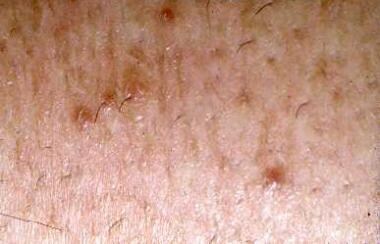Background
Perforating disorders are characterized by transepidermal elimination of altered keratin or dermal connective tissue material. These disorders include perforating folliculitis (as shown below), Kyrle disease, elastosis perforans serpiginosa, reactive perforating collagenosis, and acquired perforating dermatosis. Cases of overlap are described, and diagnostic criteria are not well-defined for all the entities. [1] Clinically, the lesions are hyperkeratotic to verrucous papules and nodules.
 Typical appearance of lesions of perforating folliculitis consisting of keratotic follicular papules.
Typical appearance of lesions of perforating folliculitis consisting of keratotic follicular papules.
In perforating folliculitis, keratotic follicular papules develop, particularly over extensor surfaces. Microscopically, the disorder is characterized by disruption of the infundibular portion of the follicular wall, with transepidermal (transfollicular) elimination of connective-tissue elements and cellular debris.
Perforating folliculitis may present as an isolated finding, apparently unrelated to other disease states, but also can be associated with chronic renal failure and diabetes mellitus. Perforating folliculitis is closely related, if not identical, to the acquired perforating dermatosis that occurs with chronic renal disease. Kyrle disease (hyperkeratosis follicularis et parafollicularis in cutem penetrans) may simply represent an exaggerated form of perforating folliculitis. In addition, another disorder of transepidermal elimination, elastosis perforans serpiginosa, occasionally displays involvement of follicular units.
Pathophysiology
As in Kyrle disease, the concept of an extrinsic keratin plug penetrating the epidermis generally has been discredited. Abnormally premature keratinization at the expense of proliferation is a possible explanation, as proposed by Carter and Constantine and Tappeiner et al in Kyrle disease. [2, 3] A role for fibronectin has been postulated. In addition, a primary alteration of connective tissue or deposition of foreign material within the superficial dermis, with subsequent engulfment and elimination by proliferative follicular epithelium, also is conceivable as a mechanism. Such a response to experimental implantation of foreign material has been described.
In addition, evidence suggests a pathologic role for excessively coiled hairs. Mehregan first proposed that curled hairs within follicular canals may act as springs, penetrating the lateral follicular wall, thereby initiating the process of transepidermal elimination. [4] Support for this concept has been provided by an ultrastructural study of acquired perforating dermatosis that showed hair shaft fragments within transepidermal channels, even in patients in whom follicular involvement was not demonstrable on routine light microscopy. Factors that may promote coiling of hairs include follicular hyperkeratosis (occasional perforated follicles can be identified in keratosis pilaris) or contact dermatitis (eg, resulting from formaldehyde in clothing). Finally, trauma, such as scratching of pruritic skin, may well play a significant role in lesional development, possibly by setting in motion one or more of the pathologic events described above. [5]
Etiology
A number of reported cases of perforating folliculitis appear to be idiopathic, but specific associations also have been observed. Although some associations could be coincidental, the association with chronic renal failure (including both dialysis-dependent and nondialysis patients) is relatively common, suggesting a pathogenetic link. [6, 7, 8, 9, 10, 11] Perforating folliculitis also is observed relatively commonly in association with diabetes mellitus.
Less common associations include sclerosing cholangitis, [12, 13] hypertension, atherosclerotic cardiovascular disease, acanthosis nigricans, psoriasis, [14] and phrynoderma. [15] A single case report described an association with Poland syndrome (unilateral absence of the pectoralis major muscle and ipsilateral symbrachydactyly), but this patient also had diabetes mellitus, hyperuricemia, and dilated cardiomyopathy. [16] A single case highlighted the presence of perforating folliculitis in a patient with human immunodeficiency virus infection. [17] A case of perforating folliculitis was also reported in a child with cystic fibrosis. [18] One case of perforating folliculitis arising in a patient with preexisting antisynthetase syndrome has been reported. [19]
Drug-induced cases include associations with infliximab and etanercept as possible inciting agents in a patient with rheumatoid arthritis [20] and dose-dependent association of sorafenib with skin lesions of perforating folliculitis. [21, 22, 23, 24, 25, 26] A report of a relationship with nilotinib suggests that drugs that inhibit c-kit and PDGF-R affect normal hair follicle development. PDGF-R has been previously linked in murine and human in vitro models to affect the hair follicle cycle. [27] A case of bendamustine-rituximab chemotherapy-induced perforating folliculitis was reported in 2017. [28]
Epidemiology
Frequency
Incidence of perforating folliculitis worldwide is not known precisely, although the disorder is not uncommon. In Detroit, Michigan, 50 cases were reported during a 2-year period in the early 1970s, although this observation was followed by a declining incidence of new cases.
Race
Although generally no ethnic predilection has been identified, 1 study found a higher incidence of Kyrle disease in chronic renal failure among African American individuals.
Sex
Perforating folliculitis occurs equally in males and females; no sex predilection has been reported.
Age
Perforating folliculitis is more common in the second through fourth decades of life.
Prognosis
Perforating folliculitis morbidity is associated with the cosmetic appearance of lesions and the pruritus that occasionally accompanies them. Although cutaneous disease is insignificant, substantial morbidity or mortality rates can be seen in association with the primary underlying diseases, such as diabetes mellitus or chronic renal failure.
Skin lesions can improve or clear, either spontaneously or with therapy. Further therapeutic experience may permit the development of specific treatment guidelines.
Reports of improvement of perforating folliculitis lesions with stabilization of renal damage (in patients with chronic renal failure) are encouraging and underscore the important role of internal medicine or surgery consultants in treating these patients.
Patient Education
Inform perforating folliculitis patients about the nature of the disease and its relation to any underlying medical condition that may be present.
Instruct perforating folliculitis patients to avoid rubbing or scratching the lesions, since this may result in their spread or in the development of secondary infection.
Fully inform patients about the treatment being used, including its proper use or application and possible adverse effects.
-
Typical appearance of lesions of perforating folliculitis consisting of keratotic follicular papules.









